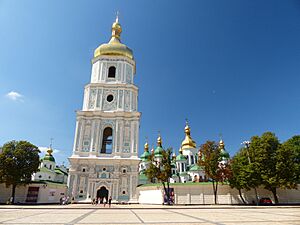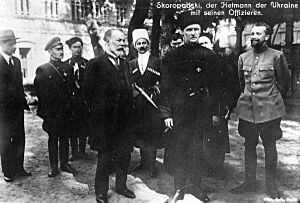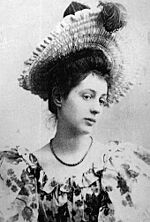Pavlo Skoropadskyi facts for kids
Quick facts for kids
Pavlo Skoropadskyi
|
|
|---|---|
| Павло Скоропадський | |

Skoropadskyi in 1920, colourized
|
|
| Hetman of all Ukraine | |
| In office 29 April 1918 – 14 December 1918 |
|
| Preceded by | Mykhailo Hrushevsky (as President of Central Rada) |
| Succeeded by | Volodymyr Vynnychenko (Chairman of the Directory) |
| Personal details | |
| Born | 15 May 1873 Wiesbaden, Hesse-Nassau, Prussia, German Empire |
| Died | 26 April 1945 (aged 71) Metten, Bavaria, Nazi Germany |
| Political party | Ukrainian People's Assembly |
| Spouse | Oleksandra Skoropadska |
| Children | Danylo Skoropadskyi Maria Yelyzaveta Olena Skoropadska-Ott |
| Relatives | Skoropadsky family |
| Awards | Order of St. George (1914) Order of St. Vladimir Order of St. Anna Order of St. Stanislaus |
| Signature | |
| Military service | |
| Allegiance | |
| Years of service | 1891–1918 |
| Rank | Lieutenant General |
| Battles/wars |
|
Pavlo Petrovych Skoropadskyi (Ukrainian: Павло Петрович Скоропадський; 15 May 1873 – 26 April 1945) was an important Ukrainian leader. He was a military general and a nobleman. From April to December 1918, he served as the Hetman of the Ukrainian State. This happened after a coup d'état on April 29, 1918.
Pavlo was born into a noble family. He became an officer after attending a special military school. He fought in the Russo-Japanese War. After that, he became a colonel and later a major general. During World War I, he was a lieutenant general. He led the 34th Army Corps.
After the February Revolution, Skoropadskyi helped make his army corps more Ukrainian. It became known as the 1st Ukrainian Corps. With help from the German Empire, he overthrew the Ukrainian People's Republic. He then created the Ukrainian State. During his time as Hetman, his government improved education and foreign relations. They also organized the Ukrainian army.
Contents
Pavlo Skoropadskyi's Background
Pavlo Skoropadskyi came from the Skoropadsky family. This family had many Ukrainian military leaders and statesmen. They were important since the 1600s. His ancestor, Ivan Skoropadsky, was a Hetman of the Ukrainian Cossacks from 1708.
Pavlo's father, Petro Skoropadsky, was a Cavalry Guard Colonel. He fought in the Caucasian War. His grandfather, Ivan Mikhailovich Skoropadskyi, was also a public leader. He was known for building the Trostyanets Arboretum. This is a beautiful park with many trees.
Pavlo grew up on his family's estate in Trostianets. He went to school in Starodub. Later, he graduated from the Page Corps cadet school in Saint Petersburg.
Military Career and Achievements
Early Military Service
In 1893, Skoropadskyi finished the Page Corps school. He joined the Chevalier Guard regiment as a cornet, which is like a second lieutenant in the cavalry. He was promoted to first lieutenant in 1897. That same year, he married Aleksandra Petrovna Durnovo. Her father was a governor in Moscow.
Skoropadskyi's first big assignment was in the Russo-Japanese War. He commanded a company of Cossacks. He later became an assistant to General Nikolay Linevich. During this war, he received several awards for his bravery. In 1905, Tsar Nikolai II made him a colonel. In 1910, he became the commander of the 20th Finnish Dragoon Regiment. By 1912, he was promoted to major general.
Service in World War I
When World War I began, Skoropadskyi led the 1st Brigade of the 1st Cavalry Guard Division. His regiment fought bravely in battles near Kraupishken in 1914. This was part of the Russian invasion of East Prussia. He also commanded other cavalry divisions.
In 1916, he became a lieutenant general. From January to July 1917, he was in charge of the 34th Army Corps. In July 1917, this corps became the 1st Ukrainian Corps. In October 1917, he was given the honorary title of Otaman by the Free Cossacks. His 60,000-man army corps successfully defended important railway lines in Ukraine.
Political Leadership in Ukraine
In April 1918, German forces entered Ukraine. They helped Skoropadskyi become the Hetman of Ukraine. Germany wanted to get food and raw materials from Ukraine. Some Ukrainian nationalists did not like Skoropadskyi. They saw him as a German helper. They also thought he was too pro-Russian and acted like a dictator.
Skoropadskyi chose many Russian-speaking officials for his government. He also wanted Ukraine to join a restored Russian Empire later. However, his government did achieve some important things. It created a good administrative system. It also formed diplomatic ties with many countries. His government signed a peace treaty with Soviet Russia. They also founded many schools and universities. This included the National Academy of Sciences of Ukraine.
On November 11, 1918, Germany signed an armistice, ending World War I. This meant the Hetmanate lost its main support. In the same month, an uprising began in Ukraine. It was led by Symon Petliura. This uprising brought back the Ukrainian People's Republic. But power was held by a group called the Directoria. Pavlo Skoropadskyi signed a document to give up his power on December 14, 1918.
Life in Exile
After leaving Kyiv, Skoropadskyi went with the German forces. He moved to Germany in 1919. He lived in Berlin. He stayed friends with many German government and army officials. But he always refused to work with the Nazis.
In the last weeks of World War II, Skoropadskyi fled from the advancing Soviet army. He was wounded in an Allied bombing raid in Germany. He died on April 26, 1945, and was buried in Oberstdorf.
His political movement continued for some time after his death. It influenced Ukrainian monarchists who wanted a Cossack State. His daughter, Olena Skoropadska-Ott, lived in Switzerland. She visited Ukraine many times and was honored for her historical writings.
Awards and Recognitions
 Order of St. Anne 4th degree, 1904
Order of St. Anne 4th degree, 1904 Order of St. Anne 3rd degree with swords and bow, 1904
Order of St. Anne 3rd degree with swords and bow, 1904Order of St. Stanislaus 2nd class with swords, 1905
 Order of St Vladimir, 4th degree with swords and bow, 1905
Order of St Vladimir, 4th degree with swords and bow, 1905- Gold Sword for Bravery, 1905
 Order of St. Anne 2nd degree with swords, 1906
Order of St. Anne 2nd degree with swords, 1906 Order of St Vladimir, 3rd degree, 1900
Order of St Vladimir, 3rd degree, 1900 Order of St. George, 4th class,
Order of St. George, 4th class, Order of the Red Eagle, 1918 (Prussia)
Order of the Red Eagle, 1918 (Prussia)
Pavlo Skoropadskyi's Family
| Coat of arms |  |
|---|---|
| [[]] | Skoropadsky family |
| Coat of arms |  |
|---|---|
| [[]] | Durnovo family |
On January 11, 1897, Pavlo Skoropadskyi married Aleksandra Petrovna Durnovo. She was a Russian noblewoman. Her family also had important statesmen. They had six children:
- Maria (1898 – 1959)
- Yelyzaveta (1899 – 1976)
- Petro (1900–1956)
- Danylo Pavlovich Skoropadskyi (1904 – 1957), who became a leader of Ukrainian monarchists.
- Pavlo (1915–1918), who died young.
- Olena (1919 – 2014), who had two daughters: Alexandra and Irene.
Legacy and Remembrance
Today, some cities in Ukraine have streets named after Pavlo Skoropadskyi.
In 2023, the National Bank of Ukraine released a special coin. It was a 2 hryvni coin. This coin honored the 150th anniversary of Pavlo Skoropadskyi's birth.
See also
- Hromada
- Free Cossacks
- List of Ukrainian rulers
|
Pavlo Skoropadskyi
Family of Skoropadsky
Born: 3 May 1873 Died: 26 April 1945 |
||
| Regnal titles | ||
|---|---|---|
| Preceded by title created |
Hetman of Ukraine 1918 |
Succeeded by none |
| Titles in pretence | ||
| Preceded by none |
Hetman of Ukraine 1918–1945 |
Succeeded by Oleksandra Skoropadska-Ott |




